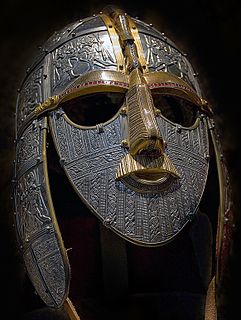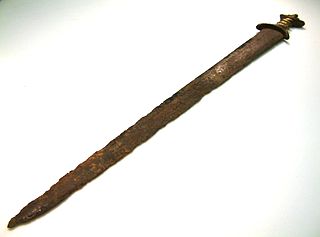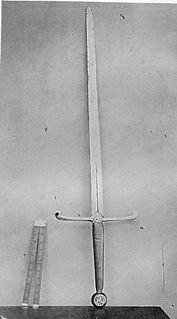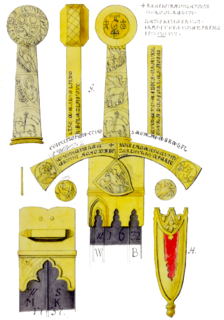 W
WThe Oakeshott typology was created by historian and illustrator Ewart Oakeshott as a way to define and catalogue the medieval sword based on physical form. It categorises the swords of the European Middle Ages into 13 main types, labelled X through XXII. Oakeshott introduced it in his 1960 treatise The Archaeology of Weapons: Arms and Armour from Prehistory to the Age of Chivalry.
 W
WThe Abingdon Sword is a late Anglo-Saxon iron sword and hilt of the late 9th or early 10th century; only the first few inches of the blade remain attached to the hilt.
 W
WMany different weapons were created and used in Anglo-Saxon England between the fifth and eleventh centuries. Spears, used for piercing and throwing, were the most common weapon. Other commonplace weapons included the sword, axe, and knife—bows and arrows, as well as slings, were not frequently used by the Anglo-Saxons. For defensive purposes, the shield was the most common item used by warriors, although mail and helmets were sometimes used.
 W
WThe Cawood sword is a medieval sword discovered in the River Ouse near Cawood in North Yorkshire in the late 19th century. The blade is of Oakeshott type XII and has inscriptions on both sides. It most likely dates to the early 12th century.
 W
WA ceremonial weapon is an object used for ceremonial purposes to display power or authority. They are often used in parades and as part of dress uniforms.
 W
WA claymore is either the Scottish variant of the late medieval two-handed sword or the Scottish variant of the basket-hilted sword. The former is characterised as having a cross hilt of forward-sloping quillons with quatrefoil terminations and was in use from the 15th to 17th centuries.
 W
WColada is one of the two best-known swords, along with Tizona, of El Cid Campeador. Won in combat from the Count of Barcelona, the sword was presented to his sons in law. According to the heroic verses of the Cantar de mio Cid, after his sons-in-law beat his daughters and then abandoned them on the side of the road, El Cid asked for his gifts to be returned. Afterward, he bestowed the sword upon one of his knights, Martín Antolínez.
 W
WOn a sword, the crossguard, or cross-guard, also known as quillon, is a bar of metal at right angles to the blade, placed between the blade and the hilt. The crossguard was developed in the European sword around the 10th century for the protection of the wielder's hand. The earliest forms were the crossguard variant of the Spatha used by the Huns, the so-called Pontic swords. There are many examples of crossguards on Sasanian Persian Swords beginning from the early 3rd century. They might be the oldest examples. The crossguards were not only used to counter enemy attacks, but also to get a better grip on the sword. They were later seen in late Viking swords, and is a standard feature of the Norman sword of the 11th century and of the knightly arming sword throughout the high and late medieval period. Early crossguards were straight metal bars, sometimes tapering towards the outer ends. While this simple type was never discontinued, more elaborate forms developed alongside it in the course of the Middle Ages. The crossguard could be waisted or bent in the 12th and 13th century.
 W
WThe Gilling sword is an Anglo-Saxon sword, dating from the late 9th to early 10th centuries AD, found by a schoolboy in a river in 1976 and subsequently acquired by the Yorkshire Museum.
 W
WThe Grunwald Swords were a gift presented by Ulrich von Jungingen, the Grand Master of the Order of Teutonic Knights, to King Władysław II Jagiełło of Poland and Grand Duke Vytautas of Lithuania on 15 July 1410, just before the Battle of Grunwald (Tannenberg). The gift, a pair of simple bare swords, was a formal invitation to the battle. After the Polish-Lithuanian victory, both swords were taken as a war trophy by King Władysław II to Kraków, Poland's capital at the time, and placed in the treasury of the Royal Wawel Castle.
 W
WThe Imperial Sword is one of the four most important parts of the Imperial Regalia (Reichskleinodien) of the Holy Roman Empire. During a coronation, it was given to the emperor along with the Imperial Crown (Reichskrone), Imperial Sceptre (Reichszepter), and the Imperial Orb (Reichsapfel). All four parts of the Imperial Regalia are displayed in the Imperial Treasury at the Hofburg Palace in Vienna, Austria.
 W
WJoyeuse was, in medieval legend, the sword wielded by Charlemagne as his personal weapon. The name means "joyous". A sword identified as Joyeuse was used in French royal coronation ceremonies since the 13th century, and is now kept at the Louvre museum.
 W
WThe sword Lobera was the symbol of power used by Saint Ferdinand III of Castile, instead of the more traditional rod, and so the king will be depicted with orb and sword in hand.
 W
WA rain-guard or chappe is a piece of leather fitted to the crossguard of European swords of the later medieval period. The purpose of this leather is not entirely clear, but it seems to have originated as a part of the scabbard, functioning as a lid when the sword was in the scabbard.
 W
WThe Migration Period sword was a type of sword popular during the Migration Period and the Merovingian period of European history, particularly among the Germanic peoples and was derived from the Roman era spatha. It later gave rise to the Carolingian or Viking sword type of the 8th to 11th centuries AD.
 W
WThe so-called Sabre of Charlemagne is an early sabre of Hungarian (Magyar) type which has exceptionally been preserved as part of the Aachen regalia of the Holy Roman Empire. Along with the rest of the imperial regalia from both Aachen and Nuremberg, it is now kept in the Hofburg Palace, Vienna.
 W
WThe Seax of Beagnoth is a 10th-century Anglo-Saxon seax. It was found in the River Thames in 1857, and is now at the British Museum in London. It is a prestige weapon, decorated with elaborate patterns of inlaid copper, brass and silver wire. On one side of the blade is the only known complete inscription of the twenty-eight letter Anglo-Saxon runic alphabet, as well as the name "Beagnoth" in runic letters. It is thought that the runic alphabet had a magical function, and that the name Beagnoth is that of either the owner of the weapon or the smith who forged it. Although many Anglo-Saxon and Viking swords and knives have inscriptions in the Latin alphabet on their blades, or have runic inscriptions on the hilt or scabbard, the Seax of Beagnoth is one of only a handful of finds with a runic inscription on its blade.
 W
WThe Suontaka sword was found in a woman's grave in Tyrväntö, Finland in 1968. It is known that the grave dates approximately from 1030 AD and the sword has probably been in use in 10th century. The sword was made with grip and hilt entirely in hollow cast bronze. The sword blade contains texts +NMIN+ and +NIOIN+, which can be variations of the text "in the name of god". The sword is considered to be a unique work of art for its time.
 W
WThe sword of François I is a ceremonial sword made c. 1510–1515 from a blade forged around 1480 and a custom-made handle. It was captured by the Spanish at the Battle of Pavia and brought back to France in 1808 by Murat. It is currently on display at the Musée de l'Armée at Les Invalides, in Paris.
 W
WThe Sword of Saints Cosmas and Damian, also known as the Sword of Essen, is a ceremonial weapon in Essen Abbey. The sword itself dates to the mid 10th century, the gold decoration was added at the close of the 10th or the onset of the 11th century, while the silver mounts with the inscription were added 15th century.
 W
WThe Manx Sword of State is a ceremonial sword that represents the Tynwald on the Isle of Man. It represents the duties of the Sovereign of the Isle of Man, and is used every month in Tynwald, and annually during the Tynwald Day ceremony. There have been three swords used for such functions over the years. One is used for the ceremonies; one is housed in a museum; the other was lost in the 18th century. The Sword of State is popularly said to date to the mid 13th century, however it is not unlike 15th-century ceremonial swords used in England, and recent analysis dates it to the 15th century as well.
 W
WSzczerbiec is the ceremonial sword used in the coronations of most Polish monarchs from 1320 to 1764. It now is displayed in the treasure vault of the royal Wawel Castle in Kraków, as the only preserved part of the medieval Polish crown jewels. The sword is noted for its hilt, decorated with magical formulae, Christian symbols, and floral patterns, as well as for the narrow slit in the blade which holds a small shield with the coat of arms of Poland. The name of the sword, derived from the Polish word szczerba, may be rendered into English as "the Notched Sword" or "the Jagged Sword", though the edges of its blade are straight and smooth.
 W
WTizona is the name of one of the swords carried by Rodrigo Díaz de Vivar, El Cid, according to the Cantar de Mio Cid. The name of the second sword of El Cid is Colada.
 W
WThe Ulfberht swords are about 170 medieval swords found in Europe, dated to the 9th to 11th centuries, with blades inlaid with the inscription +VLFBERH+T or +VLFBERHT+. That word is a Frankish personal name that became the basis of a trademark of sorts, used by multiple bladesmiths for several centuries.
 W
WThe Wallace Sword is an antique two-handed sword purported to have belonged to William Wallace (1270–1305), a Scottish knight who led a resistance to the English occupation of Scotland during the Wars of Scottish Independence. It is said to have been used by William Wallace at the Battle of Stirling in 1297 and the Battle of Falkirk (1298).